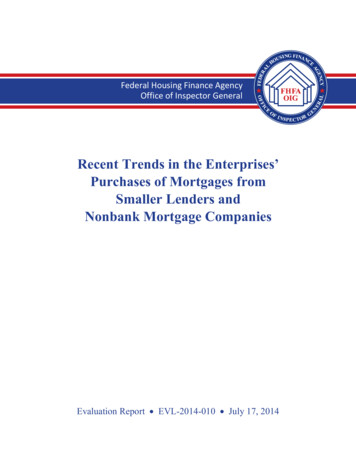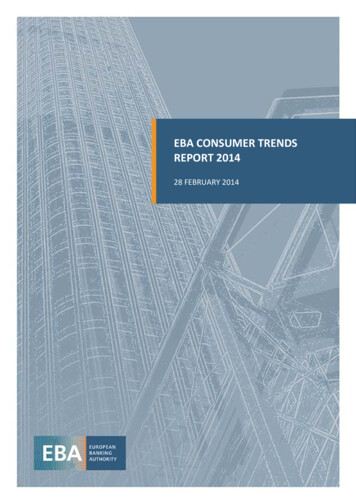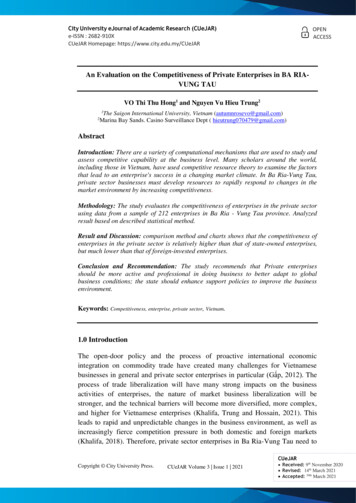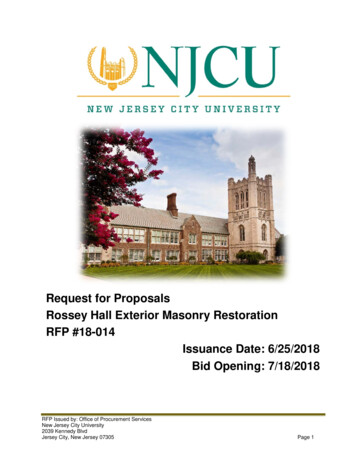
Transcription
Federal Housing Finance AgencyOffice of Inspector GeneralRecent Trends in the Enterprises’Purchases of Mortgages fromSmaller Lenders andNonbank Mortgage CompaniesEvaluation Report EVL-2014-010 July 17, 2014
Recent Trends in the Enterprises’ Purchases ofMortgages from Smaller Lenders and NonbankMortgage CompaniesWhy OIG Did This ReportAt AGlance———July 17, 2014The Federal National Mortgage Association (Fannie Mae) and the FederalHome Loan Mortgage Corporation (Freddie Mac) (collectively, theEnterprises) provide liquidity for housing finance by purchasing mortgageloans from primary mortgage lenders and securitizing them for sale in thesecondary mortgage market. In recent years, the Enterprises have seen a shiftin the composition of their mortgage sellers, with relatively fewer sales fromlarge depository institutions and more sales from smaller lenders and nonbankmortgage companies.This evaluation report documents the increase in sales to the Enterprises bysmaller lenders and nonbank mortgage companies, discusses the reasonsbehind this trend, and assesses the Federal Housing Finance Agency’s (FHFAor Agency) oversight of the Enterprises’ risk management controls.OIG AnalysisTraditionally, the Enterprises bought most of their loans from the largestcommercial banks and mortgage companies. These entities sold theEnterprises mortgages that they originated or purchased from smaller,independent lenders. Since 2011, however, the largest commercial banks andmortgage companies have reduced their purchases from smaller lenders and,therefore, sold fewer loans to the Enterprises. The figure below shows thedecline in the market share of the Enterprises’ respective top five mortgagesellers.Smaller mortgageoriginators andnonbank mortgagecompanies haveresponded to thechanging marketby developing directsales relationshipswith the Enterprises,thereby increasingtheir market share.FIGURE 5. MARKET SHARE OF THE ENTERPRISES’ TOPFIVE SELLERS (2003 Q1–2013 Q3)85%Fannie MaeFreddie Mac75%65%55%45%35%2003 2004 2005 2006 2007 2008 2009 2010 2011 2012 2013
Counterparty Risks Presented by Some Small and Nonbank SellersAt AGlanceThe increase in mortgage sales to the Enterprises by smaller lenders andnonbank mortgage companies presents the Enterprises with certain potentialbenefits and risks. For example, the shift in market share among theEnterprises’ sellers reduces the Enterprises’ highly concentrated financialexposure to their largest counterparties. However, the shift may also increasetheir exposure to certain risks and raises their costs for counterparty riskmanagement. For example: Smaller and nonbank lenders may have relatively limited financialcapacity, and the latter are not subject to federal safety and soundnessoversight. Thus, the Enterprises face an increase in the risk that thosecounterparties could default on their financial obligations; Such lenders may lack the sophisticated systems and expertisenecessary to manage high volumes of mortgage sales to the Enterprises,thereby increasing the risk that the Enterprises will suffer losses onsuch transactions; and, Some nonbank lenders may present the Enterprises with an elevatedrisk of reputational harm. For example, we identified one suchinstitution that was sanctioned by state regulators for engaging inabusive lending practices.———July 17, 2014FHFA’s Oversight of the Enterprises’ Risk Controls for Small and NonbankLendersDuring 2013, FHFA conducted high-level examinations of the Enterprises’counterparty risk management controls and reviewed the risks associated withspecialized mortgage servicers. However, we concluded that, due to otherexamination priorities, FHFA did not test and validate the effectiveness ofthe controls put in place by the Enterprises to address the recent increase inmortgage sales from smaller and nonbank lenders.The Agency’s 2014 planning documents indicate that it has scheduled severalexaminations of the Enterprises’ management of the risks associated with theirsmaller lenders and nonbank mortgage companies. Further, FHFA officialssaid that the Agency is developing guidance intended to strengthen theEnterprises’ counterparty risk management.We will continue monitoring the effectiveness of the Agency’s efforts tooversee this critical issue.FHFA and the Enterprises provided us with technical comments on this report.
TABLE OF CONTENTS .AT A GLANCE .2ABBREVIATIONS .6PREFACE .7CONTEXT.9The Enterprises Purchase Mortgages Primarily from Depository Institutions andNonbank Mortgage Companies .9Depository Institutions.9Mortgage Companies.10Overview of the Enterprises’ Mortgage Sale Processes .11The Enterprises Set Loan Quality Standards for the Mortgages they Purchasefrom Lenders .11Lenders Swap their Mortgages for MBS or Sell them for Cash .11The Enterprises May Require Sellers to Repurchase Mortgages that Do NotComply with their Underwriting Standards .12Lenders Often Service the Mortgages They Sell to the Enterprises .13Large Financial Institutions May Aggregate and Sell Smaller Lenders’ MortgageLoans to the Enterprises.13The Aggregation System Offered Financial and Other Benefits to theParticipants .14Many Aggregators Have Failed or Withdrawn from the Business Since theFinancial Crisis Due to Changing Economic Circumstances and RegulatoryInitiatives .15Smaller Lenders and Nonbank Mortgage Companies Have Increased Their DirectSales of Mortgages to the Enterprises .17The Number of Active Seller Counterparties Has Increased at Both Enterprises .17The Market Share of the Enterprises’ Largest Mortgage Sellers Has DeclinedSignificantly .18Significant Increase in Mortgage Lender Cash Sales to the Enterprises .19Increased Sales Percentages from Nonbank Mortgage Companies.20OIG EVL-2014-010 July 17, 20144
Nonbank Specialty Servicers Have Initiated Mortgage Sales to the Enterprises .22Risks and Challenges Associated with the Increase in Mortgage Sales by SmallerLenders and Nonbank Mortgage Companies .23Elevated Counterparty Credit Risks .23Elevated Operational Risks.26Elevated Reputational Risk.26The Risk Management Controls Put in Place by the Enterprises to Address theIncrease in Direct Sales from Smaller Lenders and Nonbank Mortgage Lenders .27FHFA’s Oversight of the Enterprises’ Risk Management Controls for MortgageSales from Smaller Lenders and Nonbank Mortgage Companies.29FHFA’s Examiners Assessed the Enterprises’ General Counterparty andSpecialized Mortgage Servicer Risk Management in 2013, but Did NotFocus on their Controls for Smaller and Nonbank Lenders.29DER Plans to Conduct Examination Activities in 2014 .30DSPS Has Issued, and Is Developing, Guidance for the Enterprises onCounterparty Risk Management.31CONCLUSIONS.32OBJECTIVE, SCOPE, AND METHODOLOGY .33ADDITIONAL INFORMATION AND COPIES .34OIG EVL-2014-010 July 17, 20145
ABBREVIATIONS .DERDivision of Enterprise RegulationDHMGDivision of Housing Mission and GoalsDSPSDivision of Supervision Policy and SupportEICExaminer in ChargeEnterprisesFannie Mae and Freddie MacFDICFederal Deposit Insurance CorporationFannie MaeFederal National Mortgage AssociationFreddie MacFederal Home Loan Mortgage CorporationFHFA or AgencyFederal Housing Finance AgencyFSOCFinancial Stability Oversight CouncilMBSMortgage-Backed SecurityOCAOffice of the Chief AccountantOCCOffice of the Comptroller of the CurrencyOFAMSOffice of Financial Analysis, Modeling and SimulationsOIGFederal Housing Finance Agency Office of Inspector GeneralUPBUnpaid Principal BalanceOIG EVL-2014-010 July 17, 20146
PREFACE.Fannie Mae’s and Freddie Mac’s statutory mission is to provide stability, affordability, andliquidity to the secondary market for residential mortgages.1 The Enterprises carry out thismission by purchasing qualifying mortgage loans from the banks and other lenders thatoriginate them. The Enterprises then bundle the loans into mortgage-backed securities (MBS)that may be purchased by investors.2Historically, large commercial banks and other financial companies often acted as loan“aggregators,” purchasing mortgages originated by smaller lenders and selling them to theEnterprises along with loans they originated through their own lending operations.3 Theaggregators were responsible for ensuring that the loans they sold to the Enterprises met theirunderwriting standards.This system benefitted both the smaller lenders and the Enterprises. The smaller lendersreceived favorable compensation for their mortgage loans, and the Enterprises were ableto focus their counterparty risk oversight on the performance of the relatively few largeaggregators from which they bought the majority of their mortgage loans.Since the financial crisis of 2007, many of the surviving large aggregators have reduced theamount of loans they purchase from other lenders, and they sell fewer loans to the Enterprises.Consequently, smaller lenders sell substantially more loans directly to the Enterprises, as do aclass of financial institutions known as nonbank mortgage companies.4The increase in purchases directly from smaller financial institutions and nonbank mortgagecompanies offers the Enterprises some potential benefits, such as lower concentration risk.5On the other hand, it may increase counterparty credit risk, which stems primarily from twosources. First, some smaller lenders and nonbank mortgage companies have limited financialcapacity; second, in some instances, they are subject to less comprehensive federal oversight1See Federal National Mortgage Charter Act (12 U.S.C. 1716) and Federal Home Loan Mortgage CorporationAct (12 U.S.C. 1451 Note).2The Enterprises’ contribution to the secondary mortgage market is substantial. During 2013, Fannie Mae andFreddie Mac securities accounted for 76% of all new MBS issuances.3In this report, we define small lenders based on their quarterly mortgage sales volume to the Enterprises.4See page 10 for a definition of, and additional information about, nonbank mortgage companies.5The highly concentrated nature of the Enterprises’ business with several large financial institutions places theEnterprises at risk that their financial condition and operations could be significantly affected if one of theirlarge counterparties fails, defaults on its contractual obligations, or ceases doing business with an Enterprise.Thus, diversification of mortgage sales among a broader pool of smaller sellers has reduced the Enterprises’concentration risk.OIG EVL-2014-010 July 17, 20147
than larger financial institutions. Consequently, some may pose a heightened risk of financialloss to the Enterprises.In this report, we discuss the recent rise in direct sales to the Enterprises by smaller financialinstitutions and nonbank mortgage companies and several of the reasons behind this trend.We also identify the risks and challenges associated with it, and discuss FHFA’s and theEnterprises’ risk management and oversight efforts.This report was prepared by Simon Z. Wu, Ph.D., Chief Economist; Jon Anders, ProgramAnalyst; and Wesley M. Phillips, Director of the Division of Oversight and Review. Weappreciate the cooperation of all those who contributed to this effort.This report has been distributed to Congress, the Office of Management and Budget, andothers, and will be posted on OIG’s website, www.fhfaoig.gov.Richard ParkerDeputy Inspector General for EvaluationsOIG EVL-2014-010 July 17, 20148
CONTEXT .The Enterprises Purchase Mortgages Primarily from Depository Institutions andNonbank Mortgage CompaniesThe majority of the Enterprises’ mortgage lender counterparties are depository institutions,their subsidiaries, and nonbank mortgage companies.6 Depository institutions and nonbankmortgage companies both contribute substantially to housing finance. However, as describedbelow, there are distinct differences in their business models and the degree to which they areregulated.Depository InstitutionsDepository institutions, referred to in this report as banks, are financial firms whose primarybusiness is taking deposits and making loans. A governmental entity at the national orstate level charters them, and their deposits are insured, in part, against loss. In addition,depository institutions are subject to federal supervision, including examinations of theirfinancial safety and soundness. Depository institutions are: Commercial banks, which are chartered at the state or national level and subject tostate or federal regulatory supervision. On the federal level, supervision may beprovided by the Office of the Comptroller of the Currency (OCC), the Federal ReserveSystem, or the Federal Deposit Insurance Corporation (FDIC).7 The FDIC alsoinsures deposits in commercial banks for at least 250,000. In addition to takingdeposits and lending, commercial banks may operate other business lines, includinginvestment banking and credit card operations. Commercial banks vary in size fromsmall community lenders to the largest national bank holding companies.8 As ageneral matter, large commercial banks have better access to financing and capitalthan other financial institutions.6The Enterprises also purchase single-family mortgage loans from state and local housing finance agencies,insurance companies, and investment banks, among others. According to data provided by the Enterprises,depository institutions, their subsidiaries, and nonbank mortgage companies supplied nearly 100% of theirmortgages in the third quarter of 2013.7The Federal Reserve, FDIC, and state bank regulators oversee state chartered commercial banks.8According to the FDIC, community banks are often privately owned, operate within a limited market area,and are more likely to engage in mortgage lending based on specialized knowledge of their community ratherthan the model-based underwriting employed by larger banks. See FDIC, FDIC Community Banking Study,“Chapter 1 – Defining the Community Bank,” at 1-1, 1-5 (December 2012) (online t/CBSI-1.pdf).OIG EVL-2014-010 July 17, 20149
Credit unions, which are member-owned, not-for-profit financial cooperatives thatprovide savings, credit, and other financial services to their members. Credit unionspool their members’ savings deposits and shares to finance their own loan portfoliosrather than rely on outside capital. Members may benefit from higher returns onsavings, lower rates on loans, and fewer fees on average. The National Credit UnionAdministration charters and supervises federal credit unions and insures deposits infederal and most state-charted credit unions through the National Credit Union ShareInsurance Fund.9 Thrifts, which are financial institutions that generally possess the same depository,credit, and account transactional functions as commercial banks. However, they areorganized and operate primarily to promote savings and home mortgage lending asopposed to commercial lending. In 2011, the OCC assumed supervisory responsibilityfor federal thrifts from the now-defunct Office of Thrift Supervision. The FDICinsures thrift deposits.Mortgage CompaniesMortgage companies specialize in the origination, sale, and/or servicing of real-estatemortgage loans. Included in this group are independent nonbank mortgage companies andsubsidiaries of commercial banks that specialize in mortgage lending. In this report wediscuss primarily the growth of and risks associated with a subset of the above—nonbankmortgage companies that are unaffiliated with commercial banks. In general, nonbankmortgage companies:9 Are monoline businesses that rely largely upon short-term funding sources, such aslines of credit from commercial banks, which may be threatened during periods offinancial stress. Some nonbank firms also obtain funding through the issuance oflong-term debt; Vary in size from small, local mortgage lenders to large, nationwide lending firms;and Are typically capitalized to a lesser extent than large commercial banks and are notsubject to the same degree of federal regulatory oversight that chartered commercialbanks receive.10State governments may also charter credit unions.10The Dodd-Frank Wall Street Reform and Consumer Protection Act of 2010 created the Consumer FinancialProtection Bureau (CFPB) and authorized it to supervise and examine compliance with consumer protectionlaws by mortgage lenders, consumer and student loan providers, and certain larger nonbank marketOIG EVL-2014-010 July 17, 201410
Overview of the Enterprises’ Mortgage Sale ProcessesThe Enterprises Set Loan Quality Standards for the Mortgages they Purchase fromLendersLenders, including banks and mortgage companies, must ensure that the single-familymortgages they plan to sell to Fannie Mae and Freddie Mac meet the Enterprises’ standards.For example, the maximum principal balance of a mortgage offered for sale to an Enterprisemay not exceed the “conforming loan limit” which, in most locations, is now 417,000.11Moreover, the underwriting associated with such loans must meet the Enterprises’ guidelineson matters such as a borrower’s credit score and debt-to-income ratio.12 Furthermore, lendersare contractually required to represent and warrant to the Enterprises that, at the time of theirorigination, the mortgage loans they sell to the Enterprises comply with their underwritingstandards.Lenders Swap their Mortgages for MBS or Sell them for CashLenders with mortgage loans that meet theEnterprises’ standards may sell them in two ways.In a swap transaction thelender exchanges mortgagesFirst, as depicted in Figure 1A, the lender swaps thefor Enterprise MBS backed byloans for Enterprise MBS backed by those samethe same mortgages.mortgages, which the lender then sells to investors.Second, as depicted in Figure 1B, the lender sells themortgages to the Enterprise for cash, and the Enterprise securitizes the mortgages and sells theresulting MBS to investors.13 In both cases, the mortgages end-up as part of an EnterpriseMBS, and lenders obtain cash they can use to make additional loans, thereby creatingliquidity for the housing finance market.14participants. However, the CFPB does not conduct financial safety and soundness examinations of thesecompanies. See 12 U.S.C. 5514. “Larger participants of certain consumer financial product and servicesmarkets” are defined at 12 C.F.R. Part 1090.11See Federal National Mortgage Charter Act (12 U.S.C. 1717(b)(2)), the Federal Home Loan MortgageCorporation Act (12 U.S.C. 1454(a)(2)), and the Housing and Economic Recovery Act of 2008 (Pub. L. No.110-289 § 1124).12These underwriting standards serve to mitigate potential credit losses on the loans that comprise the MBSguaranteed by the Enterprises. For more information on underwriting standards, see OIG, FHFA’s Oversightof Fannie Mae’s Single-Family Underwriting Standards, at 2 (March 22, 2012) (AUD-2012-003) (online at:www.fhfaoig.gov/Content/Files/AUD-2012-003 0.pdf).13Each Enterprise may also purchase mortgage loans or MBS and hold them in its retained mortgage portfolio.14As described later in this report, larger lenders generally prefer to swap their mortgages for MBS whereassmaller lenders typically sell their mortgages to the Enterprises for cash.OIG EVL-2014-010 July 17, 201411
FIGURE 1A. LENDER SWAPS MORTGAGES FOR ENTERPRISE shInvestorsFIGURE 1B. LENDER SELLS MORTGAGES TO AN ENTERPRISE FOR sCashCashCashIn exchange for a fee, known as “the guarantee fee,” the Enterprises guarantee that investorswill continue to receive the timely payment of principal and interest on their MBS regardlessof the credit performance of the underlying mortgages.15The Enterprises May Require Sellers to Repurchase Mortgages that Do Not Complywith their Underwriting StandardsThe Enterprises have established ongoing, post-purchase quality review processes to verifythat the mortgages they purchase conform to their underwriting standards. If an Enterprisedetermines that a mortgage does not conform to its underwriting standards at the time of theloan’s origination, then the Enterprise may require the mortgage seller to repurchase themortgage at full face value or indemnify the Enterprise for any losses incurred.16 As shown inFigure 2 below, since the financial crisis the Enterprises have recovered nearly 100 billionthrough their assertion of repurchase claims.15For more information about the Enterprises’ guarantees and the fees associated with them, see OIG, FHFA’sInitiative to Reduce the Enterprises’ Dominant Position in the Housing Finance System by Raising GraduallyTheir Guarantee Fees (July 16, 2013) (EVL-2013-005) (online at: www.fhfaoig.gov/Content/Files/EVL-2013005 4.pdf) (hereinafter, OIG Guarantee Fee Report).16For example, a loan may not comply with the Enterprises’ underwriting standards if borrowers did not earnthe amount of income stated on their mortgage application.OIG EVL-2014-010 July 17, 201412
FIGURE 2. ENTERPRISE REPURCHASE REQUEST RECOVERIES, IN BILLIONSFannie MaeFreddie MacTotal2009 4.6 4.3 8.92010 8.8 6.4 15.22011 11.5 4.5 16.02012 17.1 3.5 20.62013 32.2 5.6 37.9Total 74.2 24.3 98.5Source: Fannie Mae: Form 10-K for the Fiscal Year Ended December 31, 2010, at 172; Form 10-K for theFiscal Year Ended December 31, 2011, at 175; Form 10-K for the Fiscal Year Ended December 31, 2013, at143. Freddie Mac: Form 10-K for the Fiscal Year Ended December 31, 2010, at 108, and Form 10-K for theFiscal Year Ended December 31, 2013, at 138. The figure may include some recoveries based upon violationsof Enterprise servicing guidelines. Numbers may not add to total shown due to rounding.Lenders Often Service the Mortgages They Sell to the EnterprisesMany banks and mortgage companies serve asmortgage servicers for the loans they sell toFannie Mae and Freddie Mac. That is, they actas points of contact between borrowers and theEnterprises that own the mortgage loans. Servicerstypically receive a percentage of the unpaidprincipal balance (UPB) of the mortgages theymanage as a fee for their services.On the Enterprises’ behalf, mortgageservicers collect payments fromborrowers; maintain escrow accountsfor property taxes and insurance; andhandle mortgage modifications,defaults, and foreclosures.Large Financial Institutions May Aggregate and Sell Smaller Lenders’ Mortgage Loansto the EnterprisesLarge commercial banks and mortgage companies may act as aggregators for smaller lenders,i.e., smaller commercial banks, credit unions, thrifts, and mortgage companies. They doso by purchasing mortgages originated by smaller institutions and selling the loans to theEnterprises. Figure 3, below, depicts the relationship between loan-aggregating lenders andsmaller lenders.17 Typically, the aggregators perform the following functions: Verify that the loans meet the Enterprises’ underwriting standards. To do so,the aggregators may “re-underwrite” the mortgages; that is, they review the loandocumentation to ensure compliance with the Enterprises’ requirements. Assume responsibility for the representations and warranties on the mortgage loansoriginated by smaller lenders. Accordingly, the Enterprises may seek repurchases17The type of lending described in this section is commonly known as correspondent lending. Generally,correspondent lenders complete loan processing and underwriting, fund loans in their name, and then sellclosed loans to other banks and mortgage companies, which we refer to as “aggregators.”OIG EVL-2014-010 July 17, 201413
directly from the aggregators for any mortgage loans originated by smaller lenders thatdo not meet their underwriting standards or other requirements.As explained below, the role played by large institutional aggregators has diminished sincethe financial crisis of 2008.FIGURE 3. LOAN SALES TO THE ENTERPRISES THROUGH torLendersCash Typically sell closedmortgage loans toaggregators Verify underwriting Hold liability formortgages sold toEnterprisesCash orMBSSource: OIG analysis of information provided by Fannie Mae and Freddie Mac, and Mortgage BankersAssociation, 33 Hour SAFE Comprehensive School of Mortgage Banking I, Introduction to Real Estate FinanceIndustry, Book 1 (2012).The Aggregation System Offered Financial and Other Benefits to the ParticipantsThe aggregation system provided financial benefits to both the aggregators and smallerlenders. Aggregators benefitted because the Enterprises have historically provided guaranteefee discounts to them based upon the volume of loans that they delivered. By combining theirown mortgages with those originated by smaller lenders, the aggregators received largerguarantee fee discounts from the Enterprises.18 In turn, the aggregators passed along a portionof their discounted guarantee fees to smaller lenders in the form of better prices than theEnterprises could offer them. This arrangement provided many smaller lenders with financialincentives to sell their mortgages to aggregators rather than directly to the Enterprises.Aggregators also purchased the mortgage servicingrights associated with the loans they bought fromsmaller lenders. According to representatives ofFannie Mae, this provided the primary financialincentive for smaller lenders to participate in theaggregation system. The mortgage servicing rightsprovided the aggregators with ongoing fee income andMortgage Servicing Rights arethe contractual rights to service amortgage and receive fees forthose services. They may bebought and sold among servicers.18For more information on the guarantee fees that lenders pay and the Enterprises’ historic practice ofproviding volume-based discounts, see OIG Guarantee Fee Report, at 18.OIG EVL-2014-010 July 17, 201414
the opportunity to market their other financial services directly to the mortgage borrowerswhose loans they serviced.The Enterprises also benefitted from purchasing mortgages from aggregator sellers.Specifically: The aggregators performed an additional layer of review by ensuring that mortgagesoriginated by smaller lenders met the Enterprises’ underwriting standards;19 The Enterprises did not have to track potentially hundreds of smaller lenders’ financialcondition and compliance with their selling and servicing guidelines; and Large aggregators may have had more ability to honor the Enterprises’ mortgage loanrepurchase demands because they often had greater financial resources than smallerlenders.Many Aggregators Have Failed or Withdrawn from the Business Since the FinancialCrisis Due to Changing Economic Circumstances and Regulatory InitiativesThe role played by aggregators in the sales of mortgage loans to the Enterprises prior to thefinancial crisis of 2008 was quite significant, but since then it has declined due to the failureof some aggregators, changing economic circumstances, and new regulatory requirements.Fannie Mae recently reported that only 5 of the top 20 mortgage originators of 2006 remainactive in the mortgage market today.20 The firms that failed or were absorbed by otherlenders include some of the Enterprises’ top sellers and aggregators
The highly concentrated nature of the Enterprises'business with several large financial institutions places the Enterprises at risk that their financial condition and operations could be significantly affected if one of their large counterparties fails, defaults on its contractual obligations, or ceases doing business with an Enterprise.










